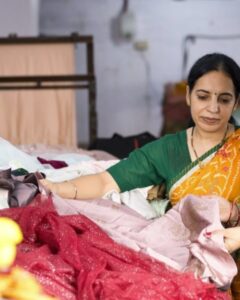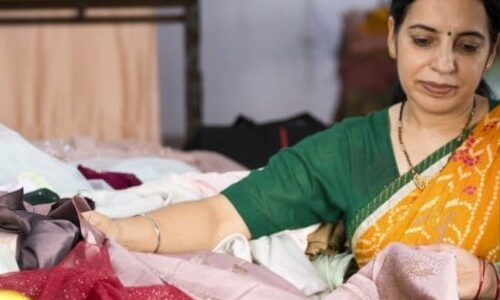Authors: Swathi Rao, Aparajita Bharti, Sona Mitra
Published: 30th October 2023 in the Hindustan Times
 The year 2023 marks a milestone as India becomes the world’s most populous country, accompanied by the promise of a burgeoning working-age population (15-59 years) that could drive an economic boom. However, this could be hampered by a lower number of women in the workforce. Government surveys reveal a decade of low rates of workforce participation (WPR) of women at a mere 26.6% (2021-22), further exacerbated by women’s confinement to low-paying and low-productivity jobs in the informal sector.
The year 2023 marks a milestone as India becomes the world’s most populous country, accompanied by the promise of a burgeoning working-age population (15-59 years) that could drive an economic boom. However, this could be hampered by a lower number of women in the workforce. Government surveys reveal a decade of low rates of workforce participation (WPR) of women at a mere 26.6% (2021-22), further exacerbated by women’s confinement to low-paying and low-productivity jobs in the informal sector.
Skilling is an important lever for improving employability, and therefore, policymakers are prioritising these initiatives. Some of these include revamping Industrial Training Institutes (ITIs), setting up National Skill Training Institutes, and creating 5,000 skill hubs, aligned with the aim of the National Education Policy 2020 to integrate practical vocational training into school curricula. There are also focused initiatives to improve the uptake of such programmes among girls. The Ministry of Skill Development and Entrepreneurship signed an MoU with the Ministry of Women and Child Development last year to improve skills of girls in non-traditional livelihoods and to ensure a smooth transition from skills to jobs. In such an ecosystem, apprenticeships offer a transition pathway by extending job-relevant training.
Under the Apprenticeship Act 1961, firms in India with six or more employees could engage apprentices, forming 2.5% to 10% of their workforce. A 2015 Government assessment reported that a skilled workforce of over 20 lakhs could be created if central public undertakings, central government, banking, and eligible MSMEs were to engage the minimum prescribed number of apprentices. Currently, the Indian government administers two primary apprenticeship programs: the National Apprentice Promotion Scheme (NAPS) and the National Apprentice Training Scheme (NATS). However, the gender-neutral design of both initiatives has played a role in fostering gender bias, which in turn, has led to the underrepresentation of women in apprenticeships.
Gender Disparities in India’s apprenticeship programs.
As of June 2023, NAPS has engaged 20,49,297 apprentices, of which 80% are male (16,44,071) while only 20% are female (4,07,568). NAPS has leveraged monthly apprenticeship melas to spread awareness and recruit apprentices during the last two-three years. Even though these melas have successfully doubled the number of apprentices between 2020-21 and 2021-22, the engagement of female apprentices remains disproportionately low.
To ensure gender-inclusive apprenticeship programs and expand their impact, a comprehensive approach is essential. This involves both tailoring initiatives to address women’s needs and extending apprenticeship opportunities across sectors. We must formulate apprenticeship programs that are women and girls-friendly by creating appropriate infrastructure for supporting and enabling women and girls, providing access to mentorship, incentivising participation in male-dominated vocations, and encouraging a role-model approach towards skilling and apprenticeship. Encouraging government apprenticeship initiatives to drive demand in others can also be effective in bringing in more women and girls.
Enhancing NAPS also requires commitment to gathering gender-disaggregated data to tailor interventions effectively. It also demands laying out a clear choice of programs, highlighting successful stories, and supportive budgetary allocations with specific targets for women and girls. The key is also to reimagine skill development, integrating foundational, transferable, and vocational skills into secondary and higher education as women’s enrolment to formal institutions across education levels increases. Industry engagement is pivotal for the success of these interventions.
Notably, Switzerland’s Vocational and Professional Education and Training (VPET) model stands as a remarkable example of effective integration of the education and skilling ecosystem. About two-thirds of Swiss youth engage in apprenticeships by age 15. VPET offers impressive flexibility, enabling seamless transitions between professions and bridging academic and vocational paths. The dual VET system is recognised as instrumental to the nation’s economic prosperity.
Switzerland’s VPET system is part of a larger trend in Europe, where several countries embrace “dual” vocational education and training, effectively combining classroom learning with practical workplace experiences. In Switzerland, 41% of VET upper secondary students are women; this is lower than the overall OECD countries average, where women students account for 45% enrolments in vocational programs. However, even with a more overall equitable distribution of enrolments, across countries men tend to dominate STEM fields (Science, Technology, Engineering, and Mathematics), while women are more prominent in areas like business, administration, law, services, health, and welfare. To address this issue, some countries have implemented measures to encourage greater female participation. For instance, in Ireland, employers who hire female craft apprentices can receive financial incentives in the form of a bursary for each female apprentice they register. This initiative has recently expanded to include all programs with more than 80% representation of a single gender.
The overall success of the European models of apprenticeships underlines the importance of data driven policy designs that can potentially be transformative in nature. Apprenticeships are powerful tools and mechanisms for transitions from education and training into jobs and need to be gender inclusive in their design. While the European examples may not be directly applicable to the Indian context, the principles of leveraging high-quality data, embracing comprehensive and inclusive program designs, and harnessing the power of incentives can serve as valuable lessons to enhance the gender responsiveness of Indian apprenticeship initiatives.
—
Swathi Rao is Analyst and Aparajita Bharti is Founding Partner at The Quantum Hub (TQH Consulting), and Sona Mitra is Principal Economist, IWWAGE.
